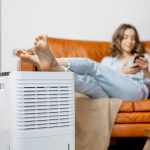Table of Contents
How Long Does It Take A Humidifier To Work?
 A humidifier begins to emit moisture immediately upon activation, but the time to significantly alter a room’s humidity levels varies based on factors like humidifier capacity, room size, and initial humidity.
A humidifier begins to emit moisture immediately upon activation, but the time to significantly alter a room’s humidity levels varies based on factors like humidifier capacity, room size, and initial humidity.
Scientifically, the rate at which humidity increases depends on the humidifier’s output capacity (measured in gallons per day) and the room’s air exchange rate.
Typically, you can start to feel the effects of increased humidity, such as easier breathing and less dry skin, within 2 to 3 hours of continuous use in a standard-sized room under normal conditions.
Achieving the ideal humidity level (30% to 50% as recommended for health and comfort) can take longer, especially in larger spaces or extremely dry environments.
| Room Size (Square Feet) | Initial Humidity Level | Expected Time to Noticeable Humidity Increase |
|---|---|---|
| Up to 250 | Very Dry (<30% RH) | 1-2 hours |
| Up to 250 | Moderately Dry (30-40% RH) | 30-60 minutes |
| 251 to 400 | Very Dry (<30% RH) | 2-3 hours |
| 251 to 400 | Moderately Dry (30-40% RH) | 1-2 hours |
| 401 to 550 | Very Dry (<30% RH) | 3-4 hours |
| 401 to 550 | Moderately Dry (30-40% RH) | 2-3 hours |
| 551+ | Very Dry (<30% RH) | 4+ hours |
| 551+ | Moderately Dry (30-40% RH) | 3-4 hours |
 Introduction: The Three-Sneeze Warning and Our Humidifier Fix
Introduction: The Three-Sneeze Warning and Our Humidifier Fix
You know, there’s a little ritual in our house that’s as predictable as clockwork, especially when winter rolls around. My wife, bless her, starts sneezing in sets of three. It’s gotten to the point where nobody even thinks about saying “bless you” or “Gesundheit” until that third one’s out. At first, we just chalked it up to one of those quirky things, but then we started noticing a pattern.
It hit me one chilly morning, right after the third sneeze echoed off the kitchen walls. The air was dry—real dry. And our humidifier? Well, it was sitting there, unplugged, like a car with no gas. That’s when the light bulb went off. Every time we forgot to turn that thing on, the air got so dry it practically invited those sneezing fits.
So, we made a change. We started keeping that humidifier running during the cold months, making sure the air in our place wasn’t just warm, but moist and comfortable too. And would you believe it? Those triple-sneeze sequences became a rare event.
This whole experience got me thinking about how something as simple as the air we breathe can make such a big difference in how we feel. That’s why I wanted to share what we learned about humidifiers. They’re not just gadgets; they’re game-changers for your health and comfort at home. So, let’s dive into what these handy devices can do and why keeping the air just right might mean fewer sneezes and a whole lot more comfort.
Types of Humidifiers and Their Efficiency
Navigating the world of humidifiers can feel like exploring a vast landscape, each type with its unique mechanism and suitability for different environments. Understanding these variations is key to choosing the right humidifier for your needs and setting realistic expectations for how quickly it can improve the humidity in your space.1
Cool Mist Humidifier
Cool mist humidifiers are among the most popular choices for increasing indoor humidity, especially in homes with children or pets due to their safety advantage of not using hot water. They come in two primary types: evaporative and ultrasonic.
- Evaporative Humidifiers work by drawing air through a moistened wick filter. As the air passes through the filter, it evaporates some of the water into the air. These models are self-regulating, as the amount of humidity they add to the air depends on the air’s current humidity level; the drier the air, the more effective they are. They might take longer to noticeably increase the humidity in a room, especially if the air is initially very dry.
- Ultrasonic Humidifiers use high-frequency vibrations to produce a fine mist of water, which is then expelled into the air. These models are typically quieter and can increase humidity levels more quickly than evaporative models. However, they may leave a fine white dust if used with hard water, and it’s advisable to use distilled water to prevent this.
Warm Mist Humidifier (Steam Vaporizers)
Warm mist humidifiers boil water to produce steam, which is then cooled slightly before being released into the air. These are particularly beneficial in colder climates as they can help warm the room slightly. However, they consume more energy due to the heating element and have a higher risk associated with the hot water they produce. In terms of efficiency, they can humidify a room relatively quickly, especially smaller spaces, but might not be as suitable for large areas.
Whole House and Furnace Humidifiers
These systems are integrated into your home’s HVAC system and add moisture to the air as it circulates through the heating and cooling system. They are efficient for consistent humidity control throughout the entire house and are particularly effective in large spaces or multi-story homes. The noticeable impact on humidity levels can vary widely based on the home’s size, the system’s capacity, and the initial dryness of the air but generally, these systems work continuously to maintain set humidity levels.
Specialized Humidifiers: Vicks Humidifier and Others
Branded humidifiers like the Vicks model often come with added features for health benefits, such as compartments for medicinal vapors. These models generally work within the same timeframes as standard cool or warm mist humidifiers for increasing humidity but can provide quicker relief for congestion or coughs due to the inhalation of medicated vapors.
 Choosing the Right Type for Your Needs
Choosing the Right Type for Your Needs
When selecting a humidifier, consider the size of the area you wish to humidify, your specific health needs (such as relief from respiratory symptoms), and the level of maintenance you’re willing to undertake. Each type of humidifier has its pros and cons, and the right choice depends on your individual requirements and the environmental conditions of your home.
| Need/Condition | Optimal Humidity Level (RH%) | Approx. Time to Achieve* |
|---|---|---|
| General Comfort and Health | 30% – 50% | 2-4 hours |
| Allergy and Asthma Relief | 40% – 50% | 3-5 hours |
| Preventing Dry Skin and Hair | 40% – 60% | 3-5 hours |
| Preserving Wooden Furniture | 40% – 55% | 3-5 hours |
| Reducing Static Electricity | 30% – 40% | 2-4 hours |
| Indoor Plant Health | 40% – 60% | 3-5 hours |
| Preventing Influenza Spread | 40% – 60% | 3-5 hours |
Optimal Duration for Running a Humidifier
Finding the right balance in humidifier operation is crucial for maximizing benefits while avoiding potential issues related to over-humidification, such as mold growth or excess condensation. The optimal duration to run a humidifier varies based on several factors, including the type of humidifier, the size and humidity level of the room, and personal comfort preferences.
General Guidelines
As a starting point, running a humidifier continuously during the hours you are at home and active, or overnight in your bedroom, can effectively maintain comfortable humidity levels. However, continuous operation may not always be necessary or optimal. Here are some specific considerations:
- For Bedrooms: Running a humidifier throughout the night can provide comfort and health benefits, especially in dry climates or during winter. A common practice is to turn on the humidifier when you go to bed and turn it off when you wake up, ensuring a comfortable sleep environment.
- For Living Areas: In common living spaces, you might run the humidifier during the day, especially if the area is in use and the air feels particularly dry. Adjusting the run time based on the current humidity level and room usage can help maintain optimal conditions.
- Monitoring Humidity Levels: The key to determining how long to run your humidifier lies in monitoring the humidity levels of your space. A hygrometer, an instrument that measures the moisture content in the atmosphere, can be an invaluable tool in this regard. Aim to maintain indoor humidity levels between 30% and 50%, as recommended by health and building experts.
Adjusting for Conditions and Needs
- During Illness: If you or a family member is suffering from congestion or a respiratory infection, running a humidifier in the sick person’s room could provide relief and may be beneficial to operate continuously, day and night, to help ease symptoms.
- Seasonal Adjustments: In colder months, indoor air tends to be drier, and you might find it necessary to run your humidifier more frequently. Conversely, during the humid summer months, you may need to use it less often or adjust the settings to maintain comfortable humidity levels.
- Room Size and Humidifier Capacity: Larger rooms or open-plan areas may require longer run times or a humidifier with a larger capacity to effectively increase and maintain humidity levels. Conversely, small rooms or those with efficient insulation may reach the desired humidity levels more quickly.
Signs of Over-Humidification
Be vigilant for signs that you might be running your humidifier too much, such as condensation on windows, damp spots on walls or ceilings, or a musty odor, which could indicate mold growth. Adjusting the run time and monitoring the humidity levels can help mitigate these risks.
Humidifiers for Health Benefits
When it comes to your health, a little boost in humidity can go a long way, especially during those dry winter months or if you’re living in a naturally arid area. If you’re battling with congestion, a humidifier can start to provide relief almost as soon as you switch it on. That moisture in the air helps loosen up the mucus, making it easier to breathe. And for folks dealing with dry skin or a persistent cough, keeping the air moist can really help soothe those irritations.
But here’s the thing, while you might notice some immediate relief, the real magic happens with consistent use. Give it a few days with the humidifier humming away, and you’ll start to see more significant changes. Your skin might not feel as tight and dry, and that annoying cough could become less frequent. It’s all about giving your body the right environment to heal and thrive in.2
How to Know if Your Humidifier is Helping
Now, you might be wondering, “How do I know if this thing’s actually doing its job?” Well, there are a few telltale signs that the air quality in your home is improving. First off, pay attention to how your skin and airways feel. If they’re not as dry as they used to be, that’s a good sign. And if you’re not getting shocked by static electricity every time you touch a doorknob or pet the cat, that’s another clue that the humidity levels are where they should be.
To get a bit more scientific, you might want to use a hygrometer—a tool that measures humidity. It’ll give you a clear readout of the moisture levels in your home, so you can adjust your humidifier settings as needed. And, of course, keep an eye on those health symptoms. If you’re sneezing less, your throat doesn’t feel as scratchy, or you’re waking up feeling more refreshed, it’s likely your humidifier is pulling its weight.
Conclusion
So, to wrap things up, humidifiers can be a real game-changer when it comes to improving the air quality in your home and giving your health a little boost. Whether it’s fighting off the dryness that comes with heating your home in the winter or providing relief from health issues like congestion and dry skin, these devices have got you covered.
Just remember, not all humidifiers are created equal. Make sure you pick one that’s the right size for your space and suited to your specific needs. And once you’ve got it up and running, give it some time to work its magic.
FAQ:
Q: How long does it take a humidifier to help with congestion?
A: A humidifier can provide immediate relief by adding moisture to the air, which helps to soothe congested nasal passages. You may start to feel relief within an hour of use, with significant improvement often occurring overnight during continuous use.
Q: What’s the timeframe for a humidifier to alleviate a sore throat?
A: The moist air produced by a humidifier can begin to relieve the discomfort of a sore throat within a few hours of use. For best results, use the humidifier in your bedroom overnight to provide continuous moisture, which can help ease the sore throat by morning.
Q: How quickly can a humidifier address issues with a bloody nose caused by dry air?
A: Using a humidifier to add moisture to dry indoor air can help prevent the nasal passages from becoming too dry and reduce the risk of bloody noses. While the effects can be felt soon after starting the humidifier, consistently maintaining optimal humidity levels (30% – 50% RH) over a few days is key to preventing recurrent bloody noses.
Q: Can a humidifier quickly improve dry skin and chapped lips?
A: Increased humidity can help soothe dry skin and chapped lips, with some individuals noticing improvement within a day of continuous use. However, for lasting effects and to fully rehydrate the skin, it’s advisable to maintain consistent use of the humidifier along with proper skin care over several days.
Q: How long does it take for a humidifier to aid in the recovery from a cough?
A: For coughs exacerbated by dry air, a humidifier can offer relief by moistening the throat and airways, making coughing less painful and more productive. Significant relief can often be noticed after the first night of use, but continuing to use the humidifier as long as the cough persists is beneficial.
Q: Is there a quick effect of humidifiers on indoor plant health?
A: Plants can show signs of improved health, such as more vibrant leaves and better growth, within a week of consistent use of a humidifier, especially in environments that were previously very dry. Some plants may respond even quicker, depending on their specific humidity needs.
Note: The effectiveness and speed at which a humidifier alleviates these symptoms can vary based on the individual, the severity of the symptoms, and the living environment. Consistent use and proper maintenance of the humidifier, along with other health measures, are important for the best results.


 Choosing the Right Type for Your Needs
Choosing the Right Type for Your Needs






